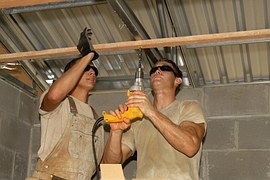By Eric Behna, Program and Policy Analyst

On August 14th, 1976 President Gerald Ford signed H.R. 12169, also known as the Energy Conservation and Production Act. Title IV of this legislation instructed the administrator of the Federal Energy Administration (now the Department of Energy) to establish a weatherization program in order to “increase the energy efficiency of dwellings owned or occupied by low-income persons, reduce their total residential energy expenditures, and improve their health and safety, especially low-income persons who are particularly vulnerable such as the elderly, persons with disabilities, families with children, high residential energy users, and households with high energy burden” (10 CFR 440.1).
Forty years later, the Weatherization Assistance Program (WAP) has provided critical weatherization services to over seven million low-income families in all 50 States, the District of Columbia, five U.S. Territories, and three Native American Tribes. The WAP provides cost-effective energy savings to American families, leads to important health and safety benefits, positively impacts the environment, and supports jobs and new technology. As we mark the 40th anniversary the Weatherization Assistance Program, let’s take a comprehensive look back at the wide ranging impacts of the WAP.
Energy Savings
The WAP’s impact on energy savings for families and society at large is well documented. A study by Oak Ridge National Laboratory released in 2014 examined over 30,000 dwelling units and 8,000 utility bills. It found that in the program year studied (2008), the WAP provided $340 million in total energy cost savings. This translates to about $283 per family per year. The savings-to-investment ratio for the WAP was 1.4, meaning that every dollar invested resulted in approximately $1.40 of savings. These savings can lead to long term financial benefits for residents – energy efficient homes are sought after by consumers in the real estate market and are often valued higher than less efficient homes.
Health and Safety Benefits
According to the Green and Healthy Homes Initiative, nearly 9 million families across the nation live in unhealthy, energy inefficient homes, leading to $82.4 billion in healthcare costs nationwide. This represents 3% of total U.S. healthcare costs and of these costs nearly $20 billion are due to asthma related illness. The WAP and energy efficiency improvements play an important role in making housing healthier and safer. Weatherization often improves indoor air quality which can mitigate allergens and other asthma triggers. Residents of weatherized units reported fewer colds and headaches, fewer hospitalizations and doctor visits, and fewer bad mental health days. When factoring in health and safety benefits, every dollar invested in weatherization returns $4.10 to society. The health and safety benefits of weatherization are highlighted by the DOE’s Weatherization Plus Health initiative.
Environmental Impact
In 2010 alone the WAP led to an estimated 7,382,000 metric ton reduction in Carbon. Low income families are often disproportionately impacted by the effects of climate change and the WAP helps mitigate this burden. The WAP also plays a role in reducing greenhouse gas emissions and assisting in the transition to a clean energy economy.
Employment and Technology Support

The WAP supports the employment of weatherization and retrofit professionals such as contractors and inspectors. In 2008 the WAP program supported 8,500 jobs and in 2010 with Recovery Act Funding that number increased to 28,000. WAP investment has also led to improved energy efficiency technologies that have benefited the entire retrofit industry. WAP Grantees have been involved in several successful Department of Energy pilot programs to develop and incorporate innovative home energy efficiency solutions such as cool roofs, solar water heating, and photovoltaics.
Intangible Benefits
The Oak Ridge study also notes a wide range of benefits for which cost savings were unable to be evaluated. These include increased home values, health impacts of refrigerator replacement, reduced forced mobility due to hazards, reduced emissions of heavy metals, and improvements in national energy security. The authors also note that reduced carrying costs on arrearages, fewer notices and customer calls, and reduced peak electricity demands benefit all ratepayers and not just the clients of the WAP.
Conclusion
Conservatively, the value of both the energy and non-energy benefits of the WAP is estimated to be about $1.8 billion. Additionally, compared to the average U.S. household, the households that the WAP serves are more likely to be the homes of senior citizens, persons living with disabilities, or single- and dual-parent households with young children. The homes themselves are more often older, less healthy, and contain more allergens or unsafe building materials. It is clear that over its 40 year history the WAP has been a significantly effective government program that has served a critical population and continually achieves the goals set out at the program’s inception.
NASCSP will be continuing to highlight the impact of the WAP during its 40th anniversary. Do you have a WAP success story you would like to share? Is your organization doing something to celebrate 40 years of weatherization? Email ebehna@nascsp.org so we can feature your story or event!





